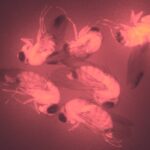Strongly expressed fluorescent protein genes that are expressed throughout development can be useful for identifying transgenic mosquitoes in the field. In a recent paper we report that the Aedes aegypti hsp83 promoter drives expression of ZsGreen and DsRed fluorescent protein genes in larvae, pupae and adults. Sophia Webster, a former doctoral student, was the first author on the study.
Whole body fluorescent protein markers for transgenic Aedes aegypti
Suppression of cage populations of Drosophila suzukii
In a recent paper in Pest Management Science, we described the evaluation of two spotted wing Drosophila male-only strains. Repeated releases of males from the FL19 strain led to suppression of established populations in cage trials.
Dispatch on sex determination and dosage compensation
In the current issue of Current Biology, Max has written a dispatch on the importance of finding that the femaleless (fle) gene is essential for development and dosage compensation inhibition in females in the malaria vector, Anopheles gambiae. In the article, Max places the fle study into a broader context of what is currently known about the sex determination and dosage compensation regulatory hierarchies in Diptera.
Recent publications on screwworm and sheep blowfly male-only strains
We recently published two papers in a special issue of BMC Genetics on the sterile insect technique. One paper led by Carolina Concha and Ying Yang describes New World screwworm strains that carry an early female lethal conditional genetic system. In the absence of tetracycline, females died at the embryo or 1st instar stages. In the second paper we describe a Lucilia cuprina strain with two lethal effectors, which could improve strain stability under mass rearing and reduce the risk of resistance in the field.
Publications on blow fly male-only strains and olfaction
As we continue to optimize genetic systems for male-only strains, we recently reported that selecting driver and effector transgenes with moderate levels of expression could be an effective strategy to obtain strains with good productivity. Ying Yan was first author and Megan Williamson a coauthor.
In a followup study to the screwworm genome paper, our collaborators Paul Hickner and Zain Syed led an investigation on screwworm olfaction, including expression of odorant receptors in antennae. This is an important step in understanding host seeking behavior of this obligate parasite.
Screwworm genome paper published
Our paper on developmental gene expression and assembly of the genome of the New World screwworm fly was published today in Communications Biology. It was a great collaborative effort involving scientists from the USDA-ARS, U. of Cincinnati, U. New Mexico, U. Kentucky, U. of São Paulo and NIH.
Welcome Aki, Alexis, Sarah and Nick!
Four people have joined the lab over the past year. Dr. Aki Yamamoto has for many years studied Drosophila melanogaster genetics. He is working on D. suzukii projects, including male-only strains. Alexis Kriete and Sarah Hudadoff recently completed the first year of the Entomology and Genetics PhD programs respectively. Alexis will work on the screwworm male-only project while Sarah plans to develop X-shredder strains in Lucilia cuprina. Most recently Nicholas Pistacchio joined the lab to maintain transgenic Lucilia lines and support the screwworm male-only project. Welcome all!
Self-Limiting Gene Drive Published
Our paper on a simple killer-rescue gene drive has been published in the Proceedings of the Royal Society B. The experimental was done by Sophia Webster, a former PhD student in the lab and the modeling by Michael Vella, a PhD student in Biomathematics. This is a simple self-limiting gene drive which should be easy to adapt to other species, including disease vectors.
Genetic Variation and Potential for Resistance to the tTA Overexpression Lethal System Published
We previously developed a female-specific tTA overexpression system for L. cuprina and C. hominivorax. We found that in some lines females with one copy of the transgene showed high survival but all females died with two copies. This suggested that relatively small changes in the level of tTA expression could significantly impact female survival. In this recently published study, we examined the impact of standing genetic variation on female survival. We used the DGRP resource, a collection of 205 highly bred Drosophila lines. We found a wide variation in female survival in different genetic backgrounds. Thus it will be important to test a transgenic strain against insects collected from the targeted location.
Improved Lucilia cuprina sexing strains published
We describe improved transgenic embryonic sexing strains for the Australian sheep blowfly in a recent article in Molecular Genetics and Genomics . We found that promoters from the L. cuprina nullo or Cochliomyia macellaria CG14427 genes drove high levels of tTA expression in the early embryo but had little activity at later stages. Production of tTA in embryos activated expression of the hid gene which lead to female lethality.

